As a kid, I hated, hated, hated operettas. Our family had a subscription to all the operettas that were performed in the Philips Entertainment Centre (a theatre in my hometown Eindhoven, the city of the Philips factories). I remember especially the lady with too much hair and too much perfume sitting before me. Because of her high style I couldn't see anything and the sweet perfume obstructed to bend forward to peak around her. So for me no Fledermaus nor Bettelstudent. And that never changed, until I discovered these witty and charming postcards of the operettas of the early sound films (and of the silent area!). So, can all these operetta fans have been wrong? Don't know, let's waltz!
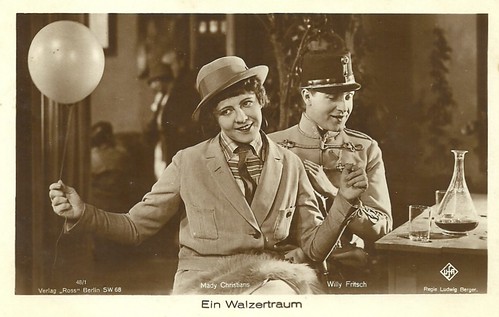
German postcard by Ross Verlag, no. 48/1. Mady Christians and Willy Fritsch in the Ufa-film Ein Walzertraum (Ludwig Berger, 1925).
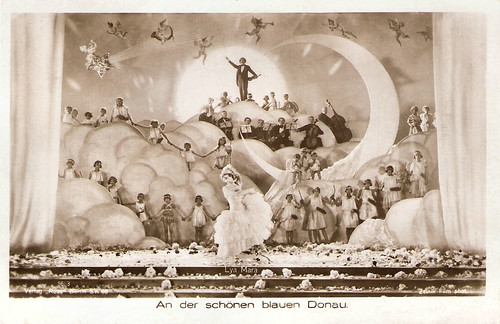
German postcard by Ross Verlag, no. 56/3, 1925-1926. Photo: Zelnik Film. Publicity still for An der schönen blauen Donau/The Beautiful Blue Danube (Friedrich Zelnik, 1926) with Lya Mara. Collection: Geoffrey Donaldson Institute.

German postcard by Ross Verlag, no. 91/2. Photo: Aafa. Publicity still for the silent Der Bettelstudent/The Beggar Student (Jacob & Luise Fleck, 1927) with Maria Paudler and Agnes Esterhazy.
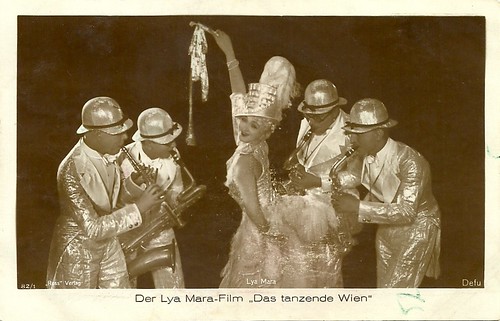
German postcard by Ross Verlag, no. 82/1. Photo: Defu. Publicity still of Lya Mara in Das tanzende Wien/Dancing Vienna (Friedrich Zelnik, 1927).
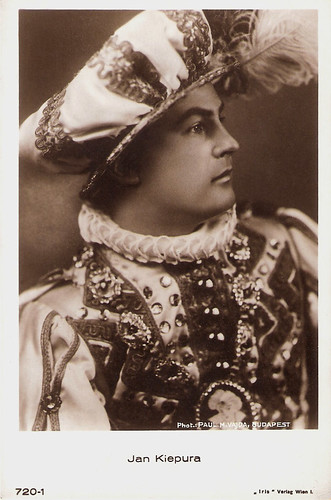
Austrian postcard by Iris-Verlag, Wien, no. 720-1. Photo: Paul M. Vajda, Budapest. Polish actor and singer Jan Kiepura (1902-1966) was one of the grand tenors of the 20th century and with his handsome smile he also became a popular film star. Solo and together with Marta Eggerth he starred in many popular film operettas of the 1930s.
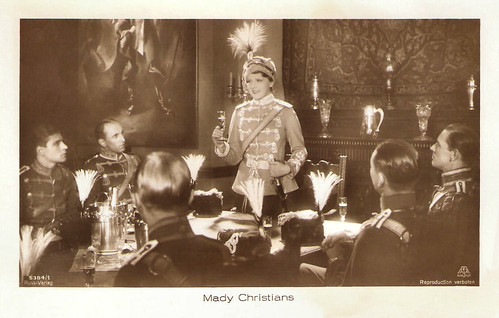
German postcard by Ross Verlag, no. 5384/1, 1930-1931. Photo: AAFA Film. Publicity still for Leutnant warst Du einst bei deinen Husaren/Lieutenant were you once with your Hussar (Manfred Noa, 1930) with Mady Christians.
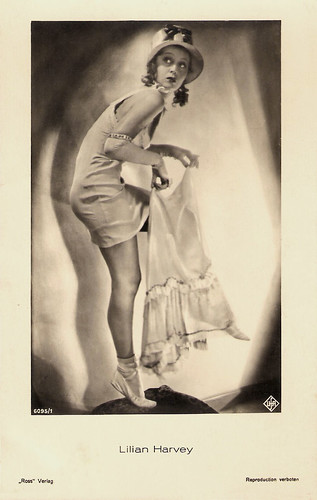
German postcard by Ross Verlag, no. 6095/1, 1931-1932. Photo: Ufa. Lilian Harvey was Ufa's biggest star of the 1930s. With Willy Fritsch she formed the 'Dream Team of the European Cinema'. Their best film was the immensely popular film operetta Der Kongress tanzt/The Congress Dances (Erik Charell, 1931).
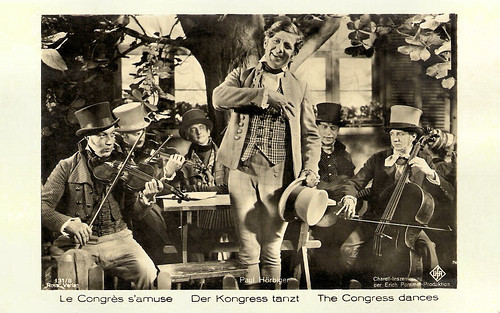
German postcard by Ross Verlag, no. 131/8. Photo: Ufa. Still from Der Kongress Tanzt/The Congress Dances (Erik Charell, 1931) with Paul Hörbiger. Der Kongress Tanzt is a sensual, made with great fun, original, capricious and extravagant operetta. It has elegance, a great cast, brilliant music and songs, wit, great sets; some scenes are even a bit bizarre and fetishistic. This is not a filmed operetta, but a real film-operetta.
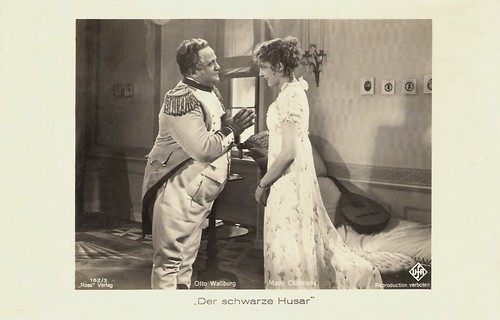
German postcard by Ross Verlag, no. 152/3 Photo: Ufa. Publicity still for Der Schwarze Husar/The Black Hussar (Gerhard Lamprecht, 1932) with Otto Wallburg and Mady Christians. Otto Wallburg appeared in supporting roles as the overweight comedian. After the rise of the Nazis the Jewish actor had to go in exile, first in Austria and later in the Netherlands. He was murdered by the Nazis in Auschwitz concentration camp.
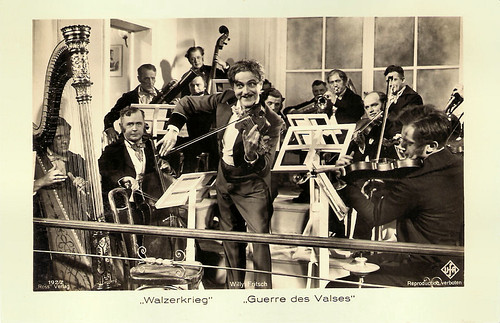
German postcard by Ross Verlag, no. 192/2, 1932-1933. Photo: Ufa. Publicity still for Walzerkrieg/Waltz Time in Vienna (Ludwig Berger, 1933) with Willy Fritsch. Collection: Geoffrey Donaldson Institute.

German postcard by Ross Verlag, no. 192/4. Photo: Ufa. Publicity still for Walzerkrieg (Ludwig Berger, 1933) with Rose Barsony and Willy Fritsch. Hungarian Rose Barsony appeared in 16 films from 1929 to 1938, and was a popular star of the operettas by Paul Abraham.
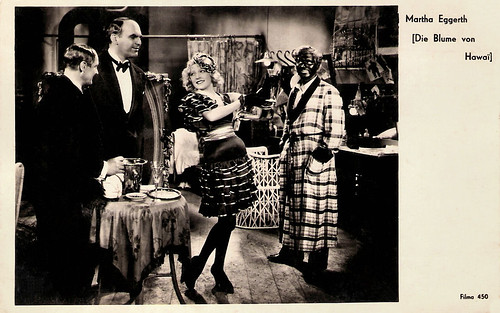
Dutch postcard by Filma, no. 450. Photo: publicity still for Die Blume von Hawaï/The Flower of Hawaii (Richard Oswald, 1933), an adaptation of the operetta The Flower of Hawaii by Paul Abraham. Star was Marta Eggerth.
This is the last post in EFSP's Dazzling Dozen series, for now.
It is Postcard Friendship Friday, hosted by Beth at the The Best Hearts are Crunchy. You can visit her by clicking on the button below.


German postcard by Ross Verlag, no. 48/1. Mady Christians and Willy Fritsch in the Ufa-film Ein Walzertraum (Ludwig Berger, 1925).

German postcard by Ross Verlag, no. 56/3, 1925-1926. Photo: Zelnik Film. Publicity still for An der schönen blauen Donau/The Beautiful Blue Danube (Friedrich Zelnik, 1926) with Lya Mara. Collection: Geoffrey Donaldson Institute.

German postcard by Ross Verlag, no. 91/2. Photo: Aafa. Publicity still for the silent Der Bettelstudent/The Beggar Student (Jacob & Luise Fleck, 1927) with Maria Paudler and Agnes Esterhazy.

German postcard by Ross Verlag, no. 82/1. Photo: Defu. Publicity still of Lya Mara in Das tanzende Wien/Dancing Vienna (Friedrich Zelnik, 1927).

Austrian postcard by Iris-Verlag, Wien, no. 720-1. Photo: Paul M. Vajda, Budapest. Polish actor and singer Jan Kiepura (1902-1966) was one of the grand tenors of the 20th century and with his handsome smile he also became a popular film star. Solo and together with Marta Eggerth he starred in many popular film operettas of the 1930s.

German postcard by Ross Verlag, no. 5384/1, 1930-1931. Photo: AAFA Film. Publicity still for Leutnant warst Du einst bei deinen Husaren/Lieutenant were you once with your Hussar (Manfred Noa, 1930) with Mady Christians.

German postcard by Ross Verlag, no. 6095/1, 1931-1932. Photo: Ufa. Lilian Harvey was Ufa's biggest star of the 1930s. With Willy Fritsch she formed the 'Dream Team of the European Cinema'. Their best film was the immensely popular film operetta Der Kongress tanzt/The Congress Dances (Erik Charell, 1931).

German postcard by Ross Verlag, no. 131/8. Photo: Ufa. Still from Der Kongress Tanzt/The Congress Dances (Erik Charell, 1931) with Paul Hörbiger. Der Kongress Tanzt is a sensual, made with great fun, original, capricious and extravagant operetta. It has elegance, a great cast, brilliant music and songs, wit, great sets; some scenes are even a bit bizarre and fetishistic. This is not a filmed operetta, but a real film-operetta.

German postcard by Ross Verlag, no. 152/3 Photo: Ufa. Publicity still for Der Schwarze Husar/The Black Hussar (Gerhard Lamprecht, 1932) with Otto Wallburg and Mady Christians. Otto Wallburg appeared in supporting roles as the overweight comedian. After the rise of the Nazis the Jewish actor had to go in exile, first in Austria and later in the Netherlands. He was murdered by the Nazis in Auschwitz concentration camp.

German postcard by Ross Verlag, no. 192/2, 1932-1933. Photo: Ufa. Publicity still for Walzerkrieg/Waltz Time in Vienna (Ludwig Berger, 1933) with Willy Fritsch. Collection: Geoffrey Donaldson Institute.

German postcard by Ross Verlag, no. 192/4. Photo: Ufa. Publicity still for Walzerkrieg (Ludwig Berger, 1933) with Rose Barsony and Willy Fritsch. Hungarian Rose Barsony appeared in 16 films from 1929 to 1938, and was a popular star of the operettas by Paul Abraham.

Dutch postcard by Filma, no. 450. Photo: publicity still for Die Blume von Hawaï/The Flower of Hawaii (Richard Oswald, 1933), an adaptation of the operetta The Flower of Hawaii by Paul Abraham. Star was Marta Eggerth.
This is the last post in EFSP's Dazzling Dozen series, for now.
It is Postcard Friendship Friday, hosted by Beth at the The Best Hearts are Crunchy. You can visit her by clicking on the button below.

No comments:
Post a Comment